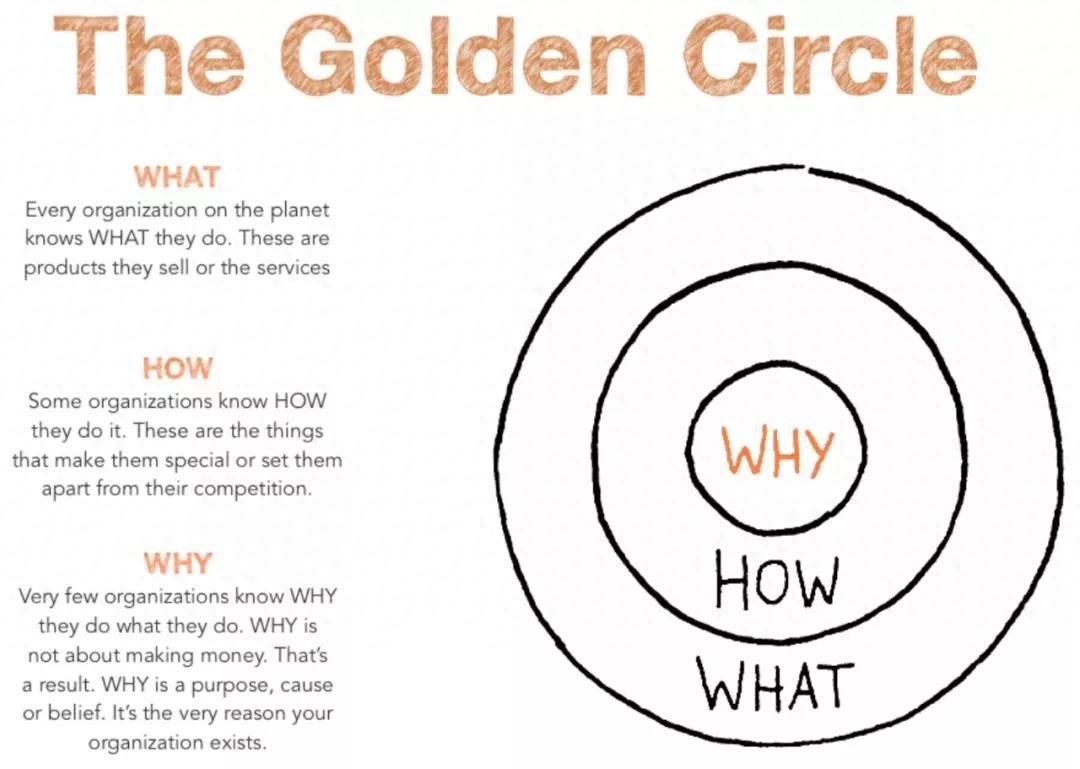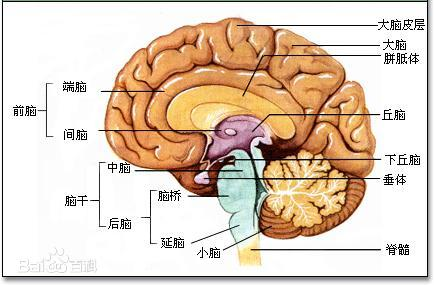Editor's introduction: Simon Sinek proposed the concept of the "Golden Circle Rule" in his book "Start with Why". He found that when people generally express or motivate others, the conventional path is: first phenomenon, Then the measures, and finally the results, this path has little effect. The path that can truly move people's hearts should be: first the idea, then the measures, then the phenomenon, and finally the results. So, how should we use the "Golden Circle Rule" to empower products?

When I first read the article about the Golden Circle Rule, I also had a thought and saw two questions and answers:
- If we opened a law firm, how would you advertise? Maybe it’s because I have a blind spot in my knowledge about the sales industry and advertising, or maybe it’s because I’ve read the original answer to this question and am preconceived, but I think I would still say, “We have the best team, they have rich experience and at the same time You have received the most powerful education, please invite us!"
- We have developed and produced a new car. How should we advertise it? And I might say, "We have an engine with incredible performance, low fuel consumption, and leather seats. Do you want to own one?" What I want to say is, this is just a low-end advertising slogan, then How to create high-end marketing? Then let’s walk into the golden circle rules together.
1. What is the golden circle rule?

As shown in the picture is the famous golden circle rule:
The golden circle rule consists of three rings, from outside to inside: WHAT - what, HOW - how, and WHY - why:
- “What”: It means what to do. Every enterprise and organization knows what they want to do, either develop a product or provide corresponding services. From a macro perspective, it is the so-called phenomena and results;
- "How": It means how to do it. Some companies know how to do it and what kind of services they provide to meet the needs of users. This is what they It is different from the different values and uniqueness of some other enterprises and organizations. In macro terms, it is methods and measures;
- “Why”: It is why these products and services are provided. Some companies know why they make these products and provide these services. Of course, this why does not refer to money. From a macro perspective, it actually refers to the purpose and philosophy of the company.
The conventional path is like the advertising slogan just mentioned, starting from the phenomenon to create marketing momentum, and going from the outside of the golden circle to the inside; while the advanced path is to start with the idea, then the measures, and then the phenomenon. This is the golden circle rule. the correct way to open.
After a preliminary understanding of the golden circle rule, if Apple is like most companies, their marketing would be like this: "We make the best products, with beautifully designed, easy-to-use, and user-friendly interfaces. Do you want to buy one?" "Will you buy?
I think most customers will not buy it, but in fact, their marketing "Everything we do is for breakthrough and innovation. We firmly believe that we should think differently; the way we challenge the status quo is Continuously design our products to be beautiful, simple, and user-friendly.
In the process, we make the best products possible. Want to buy one? "It feels completely different. Apple says that all their actions are to break through and innovate, to change the status quo, to make distinctive products and provide services that are different from other companies, that is, to change their inherent thinking.
Under the support of such a major concept, through the concept of simple design, the result of making the best products is finally achieved. In fact, Apple's products are indeed irreplaceable.
Their marketing stands in a different direction from ordinary products. From goals to results, the order of delivering information has changed. In fact, most people purchase products based on the brand concept.
I once saw Apple's famous advertisement "Think Different". The advertisement listed Einstein, Gandhi, Picasso, Edison, Chaplin, Martin Luther King, and many other outstanding figures. Jobs created this advertisement Also dubbing, he said:
"Dedicated to the crazy, the misfits, the rebels, the troublemakers. They don't like rules, they don't respect the status quo. You can respond to them or deny them, you can celebrate them or vilify them, but the only thing you can't do is Ignore them, because they change things, they move humanity forward. When some people think of them as crazy, what we see is genius. Because the people who are crazy enough to think they can change the world are the ones who actually change the world."
Through expressions such as dedication, the only thing that cannot be done, pushing mankind forward, and genius, it is not difficult to see that Jobs wanted to express his company's philosophy of changing the world by paying tribute to these extraordinary people.
And all of Apple’s achievements to date also tell us a truth: to build a company, sell a product, and provide a service, the most important and core thing is to attract like-minded customers to do business with us through ideas. This is The Golden Circle provides us with the best part.
2. "Attack the heart" is the top priority
Most people have never heard of Samuel Langley, but you must know the Wright Brothers. In the early 20th century, the enthusiasm for getting into motorized aircraft was like today's dot-com craze, everyone was trying it.
Samuel Langley had the resources and background that everyone envied: the Department of Defense gave him $50,000 as funding for the development of aircraft; he had worked at Harvard and had a wide network of contacts, and he hired the best people he could attract with the funds. Excellent talent; the market conditions were favorable, the New York Times profiled him, and everyone supported him...
But at the same time, hundreds of kilometers away on the other side in Ohio, there was a pair of brothers, Orville Wright and Wilbur Wright. They did not have any of the success factors that are generally considered. They had no money and used the income from their bicycle shop to earn money. In pursuit of their dreams, neither of the two brothers went to college, and neither of them ever received any favor from the New York Times.
On December 17, 1903, the Wright brothers successfully took off. On this day, Langley resigned. Langley's behavior confirmed his motivation for developing an aircraft. The Wright brothers and Langley are essentially different. The Wright brothers pursue a belief. They believe that if they can develop an aircraft, it will change the development process of the world. But the difference is that Samuel Langley wanted to be rich and famous, and he pursued the end result.
Those who had the same dreams as the Wright brothers worked hard with them; on the other hand, the people on Langley's team worked for a salary.
So it also shows: If you hire someone just because he can do the job, he will only work for fame and fortune. If you hire someone who shares your beliefs, they will throw their heads for you. He is passionate and will devote sweat and tears to his work.
In other words, whether it is management or product development, "attacking the heart is the top priority." When your concept happens to collide with the users' thoughts, then they will pay for your product.
3. What people buy is not the product, but your concept

There is a special discovery. From a macro perspective, the structure of the human brain is similar to the structure of the Golden Circle. The cerebral cortex corresponds to "what is" and is responsible for our rationality and logic, making our primary sensory areas ; In the middle are our two side brains, which correspond to the "how" and are responsible for our emotions and decision-making; the middle one is the thalamus, which corresponds to the "why" of the golden circle rule. The thalamus, hypothalamus, and striatum have limited maintenance relationships. Connected, the three become the subcortical center of many complex unconditioned reflexes.
In other words, whenever we communicate from the outside box, a large amount of complex information is easier for us to understand, but it is not easy to inspire our actions; when we communicate from the inside out, we control our behavior. That part of the brain does the core thinking and drives behavior, which is where heartfelt action comes from.
So for an enterprise, what you have to do is not just sell the things you have to people in need and provide services to people in need, but sell/provide them to people who share the same beliefs with you, so that they can Become your loyal users; for leaders, your goal is not just to hire someone who needs a job, but to find people who share your beliefs and make them your work partners.
Because, generally speaking, what people buy is not your product, but your belief. A classic study in the 1970s found that when a person repeatedly inputs similar content, it will become a belief; if you keep repeating your belief, you will attract people who have the same belief as you. High repetition is the best way to change the frame of others. One of the methods.
In fact, in our lives, only 2.5% of people are innovators, 13.5% are the majority who accepted it early, and the rest are those who accepted it later. So if you want to succeed in the mass market, only when you gain 15%-18% market recognition will there be a turning point for the market to open.
Because most people don't like to try new things unless there are pioneers. Forerunners take the example of the group of people who queued for a long time when the new iPhone was launched. They were not willing to wait and wanted to be the first to experience the new product. This was their own philosophy and values.
The famous speech of Dr. Martin Luther King must be familiar to many people. He was not the only great speaker in the United States, nor was he the only person who was discriminated against by the Civil Rights Act.
He did not convey what kind of changes the United States needed, but he kept repeating: "I believe... I believe... I believe..." I believe many people are also very impressed by this "I believe..." because Me too.
He repeated his belief until many people who had similar beliefs to him also repeated his belief, and it gradually became a belief shared by the 250,000 people present.
If these people are here to listen to Dr. Martin’s speech, it is not true. Everyone present is here for their own beliefs about the United States that are similar to Dr. King’s. This belief supported them for more than eight hours. Even more time was spent traveling across mountains and rivers to Washington under the scorching August sun. If this belief is a struggle caused by the injustice between blacks and whites, it is not actually the case, because 25% of the people present are white.
Dr. King said that he believed that there are two kinds of laws in the world, one is made by God, and the other is made by man. Only when the laws made by the world are consistent with the laws made by God can we truly live in a fair world. in the world. The Civil Rights Movement was just one opportunity that happened to help Dr. King put his beliefs into practice.
Did everyone who followed him do it for Dr. King’s own beliefs?
Actually no, it's for themselves. If we look back at the various plans and so-called strategies proposed by other politicians, we may find that some people may just happen to be leaders, while others are the real leaders.
Those who have true leadership and leadership qualities can not only inspire us, but also enable every follower to find their place. Traditional leaders only occupy positions of power and majesty.
In short, as a product manager, we should stand at the height of the enterprise, stand in the position of leadership, and stand within the golden circle rule. Only by standing in can we get out. Always remember that people don’t buy your product, they buy your idea.
This article was originally published by @人人操子儿 on Everyone is a Product Manager. Reprinting without the author’s permission is prohibited.
The title picture comes from Unsplash and is based on the CC0 license.
Articles are uploaded by users and are for non-commercial browsing only. Posted by: Lomu, please indicate the source: https://www.daogebangong.com/en/articles/detail/ru-he-yong-huang-jin-quan-fa-ze-fu-neng-ni-de-chan-pin.html

 支付宝扫一扫
支付宝扫一扫 
评论列表(196条)
测试